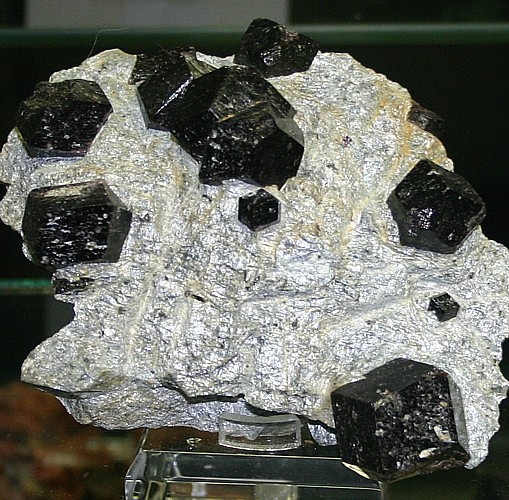|
.
Almandite Mineral Facts:
Chemical Formula:
Fe3Al2(SiO4)3
Iron-aluminium garnet. Ferric iron replaces aluminium
and magnesium replaces ferrous iron.
Colors:
Deep red,
brownish red or black.
Hardness:
7
Density:
about 4.1 to 4.3
Cleavage:
None
Crystallography: Isometric, hexoctahedral
Usually distinctly
crystallized; also in rounded grains; massive granular, coarse or fine.
When crystalized, commonly forms dodecahedron and trapezohedron, often
in combination. Hexoctahedron observed at times.
Luster:.Vitreous
glassy luster. It is transparent or translucent.
Optics:
(Refractive Index): 1.8100
|

Black Almandite Garnet |
|
Composition,
Structure and Associated Minerals:
Almandite is a common garnet is an extremely frequent mineral
in metamorphic rocks, mica schists, and gneiss; also in granites,
andesites and in some ore veins. The name is derived from the city of
Alabanda, now known as Doğanyurt in the Aydin Province, in the Asian part of
Turkey, where in ancient times garnets were cut and polished. It is one of
the commonest of all garnets. Almandite
furnishes nearly all the garnet material which is manufactured into
commercial abrasives. Transparent varieties are also used as gems. It is
widely distributed in schists and gneisses. The chief sources are the gem
gravels of Sri Lanka and the Minas Novas district of Brazil; and the mica-schists
of various parts of India, notably those of the Sarwar district of
Kishangarh State, and those of Rajmahal in Jaipur State.
Identification and Diagnostics
It is fusible before the blowpipe to a black magnetic mass. Garnets, when in crystals, are easily distinguished
from other similarly crystallizing substances by their characteristic
isometric crystals, color and hardness, etc. Massive garnet may resemble vesuvianite,
sphene, zircon or
tourmaline. It is distinguished from
zircon by its easier fusibility and from vesuvianite by its more difficult
fusibility; from tourmaline by its higher specific gravity, and from sphene
by the reaction from titanium.
It frequently requires a chemical
analysis to positively distinguish between the different members of the
group, or the percentages of each element in an individual specimen.
|
|
|
Occurrence,
Localities and Origins:
Its Its best known
occurrences in North America are at Yonkers and at various points in the
Adirondacks, N. Y., at Avondale, Pa., and on the
Stikine River, in Alaska. The varieties of almandite that are transparent
are used as gems. Other varieties too dark or included for gem use are
crushed and employed as abrasives. Abrasive garnet has been produced in the
mountain regions of New York, New Hampshire and North Carolina. The rock is
crushed and the garnet separated by hand picking, screening, or by jigging.
The crushed material is used largely in the manufacture of garnet paper.
Almandite, of gem quality, is found in northern India, Brazil, Australia,
Tanzania and in several localities in the Alps. Most Almandite gems are very
dark in color, so that larger stone appear almost black and reflect little
light. Fine crystals, although for the most part too opaque for cutting, are
found in a mica schist on Garnet Creek close to
the Stikine River,
Alaska. Garnet is Schist is known from several locations in Alaska.
Return to the
Mineral Collectors Information Page |
|



